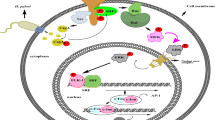Abstract
Helicobacter pylori (Hp) has strong ureaseactivity and produces a large amount of ammonia in thestomach. In animal studies, ammonia was shown toaccelerate cell kinetics of gastric mucosa, andlong-term exposure of the stomach to ammonia leads tomucosal atrophy. To understand this process, we examinedthe effects of ammonia on the growth and cell cycleprogression of human gastric cancer cell lines (HGC-27, MKN1, MKN45) using flowcytometric analysis. Ineach cell line, ammonia inhibited the cell growth in adose-dependent manner and caused significantaccumulation of S-phase cells at a cytostatic dose. DNA synthesis of HGC-27 cells treated with ammoniawas also suppressed to about 50% of that of theuntreated cells. Similar effects were observed onaddition of ammonium chloride at the same concentration, while adjusting the pH of the media with NaOHalone to that with the cytostatic dose of ammonia didnot affect the cell cycle progression. Theseobservations indicate that ammonia induces S-phasearrest in gastric cells independently of pH.
Similar content being viewed by others
REFERENCES
Warren JR, Marshall B: Unidentified curved bacilli on gastric epithelium in active chronic gastritis. Lancet 1:1273–1275, 1983
Marshall BJ, Warren JR: Unidentified curved bacilli in the stomach of patients with gastritis and peptic ulceration. Lancet 1:1311–1315, 1984
Blaser MJ: Gastric Campylobacter-like organisms, gastritis, and peptic ulcer disease. Gastroenterology 93:371–383, 1987
Morris A, Nicholson G: Ingestion of Campylobacter pyloridis causes gastritis and raised fasting gastric pH. Am J Gastroenterol 82:192–199, 1987
Marshall BJ: Virulence and pathogenicity of Helicobacter pylori. J Gastroenterol Hepatol 6:121–124, 1991
Lee A, Fox J, Hazell S: Pathogenicity of Helicobacter pylori: A perspective. Infect Immun 61:1601–1610, 1993
Hazell SL, Lee A: Campylobacter pyloridis, urease, hydrogen back diffusion, and gastric ulcer. Lancet 2:15–17, 1986
Labenz J, Börsch G: Evidence for the essential role of Helicobacter pylori in gastric ulcer disease. Gut 35:19–22, 1994
Smoot DT, Mobley HLT, Chippendale GR, Lewison JF, Resau JH: Helicobacter pylori urease activity is toxic to human gastric epithelial cells. Infect Immun 58:1992–1994, 1990
Triebling AT, Korsten MA, Dlugosz JW, Paronetto F, Lieber CS: Severity of Helicobacter-induced gastric injury correlates with gastric juice ammonia. Dig Dis Sci 36:1089–1096, 1991
Murakami M, Saita H, Teramura S, Dekigai H, Asagoe K, Kusaka S, Kita T: Gastric ammonia has a potent ulcerogenic action on the rat stomach. Gastroenterology 105:1710–1715, 1993
Mégraud F, Neman-Simha V, Brügmann D: Further evidence of the toxic effect of ammonia produced by Helicobacter pylori urease on human epithelial cells. Infect Immun 60:1858–1863, 1992
Ricci V, Sommi P, Fiocca R, Cova E, Figura N, Romano M, Ivey KJ, Solcia E, Ventura U: Cytotoxicity of Helicobacter pylori on human gastric epithelial cells in vitro: Role of cytotoxin(s) and ammonia. Eur J Gastroenterol Hepatol 5:687–694, 1993
Tsujii M, Kawano S, Tsuji S, Fusamoto H, Kamada T, Sato N: Mechanism of gastric mucosal damage induced by ammonia. Gastroenterology 102:1881–1888, 1992
Suzuki M, Miura S, Suematsu M, Fukumura D, Kurose I, Suzuki H, Kai A, Kudoh Y, Ohashi M, Tsuchiya M: Helicobacter pylori-associated ammonia production enhances neutrophil-dependent gastric mucosal cell injury. Am J Physiol 263:G719–G725, 1992
Kawano S, Tsujii M, Fusamoto H, Sato N, Kamada T: Chronic effect of intragastric ammonia on gastric mucosal structures in rats. Dig Dis Sci 36:33–38, 1991
Tsujii M, Kawano S, Tsuji S, Ito T, Nagano K, Sasaki Y, Hayashi N, Fusamoto H, Kamada T: Cell kinetics of mucosal atrophy in rat stomach induced by long-term administration of ammonia. Gastroenterology 104:796–801, 1993
Brenes F, Ruiz B, Correa P, Hunter F, Rhamakrishnan T, Fontham E, Shi T-Y: Helicobacter pylori causes hyperproliferation of the gastric epithelium: Pre-and posteradication indices of proliferating cell nuclear antigen. Am J Gastroenterol 88:1870–1875, 1993
Cahill RJ, Xia H, Kilgallen C, Beattie S, Hamilton H, O'Morain C: Effect of eradication of Helicobacter pylori infection on gastric epithelial cell proliferation. Dig Dis Sci 40:1627–1631, 1995
Akagi T, Kimoto T: Human cell line (HGC-27) derived from the metastatic lymph node of gastric cancer. Acta Med Okayama 30:215–217, 1976
Dean PN: A simplified method of DNA distribution analysis. Cell Tissue Kinet 13:299–308, 1980
Markwell MAK, Haas SM, Bieber LL, Tolbert NE: A modification of the Lowry procedure to simplify protein determination in membrane and lipoprotein samples. Anal Biochem 87:206–210, 1978
Rabkin R, Palathumpat M, Tsao T: Ammonium chloride alters renal tubular cell growth and protein turnover. Lab Invest 68:427–438, 1993
Townsley MC, Paradiso AM, Machen TE: Na/H exchange in antral cells isolated from necturus, rabbit, and guinea pig. Gastroenterology 95:302–310, 1988
Zetterberg A, Engström W: Mitogenic effect of alkaline pH on quiescent, serum-starved cells. Proc Natl Acad Sci USA 78:4344–4338, 1981
Busa W, Nuccitelli R: Metabolic regulation via intracellular pH. Am J Physiol 246:409–438, 1984
Hata M, Yamazaki Y, Ueda T, Kato T, Kohli Y, Fujiki N: Influence of ammonia solution on gastric mucosa and acetic acid induced ulcer in rats. Eur J Histochem 38:41–52, 1994
Wang X-Q, Ellem KAO: Heterogeneity in the HeLa cell cycle response to UVC analyzes by the BrdUrd two-parameter method. Exp Cell Res 212:176–189, 1994
Kochiyama T: Clinical study of Campylobacter pylori in stomach disease. Gastroenterol Endosc 31:3–13, 1989
Kim H, Park C, Jang WI, Lee KH, Kwon SO, Robey-Cafferty SS, Ro JY, Lee YB: The gastric juice urea and ammonia levels in patients with Campylobacter pylori. Am J Clin Pathol 94:187–191, 1990
Neithercut WD, Milne A, Chittajallu RS, Nujumi AME, McColl KEL: Detection of Helicobacter pylori infection of the gastric mucosa by measurement of gastric aspirate ammonium and urea concentrations. Gut 32:973–976, 1991
Rights and permissions
About this article
Cite this article
Matsui, T., Matsukawa, Y., Sakai, T. et al. Ammonia Inhibits Proliferation and Cell Cycle Progression at S-Phase in Human Gastric Cells. Dig Dis Sci 42, 1394–1399 (1997). https://doi.org/10.1023/A:1018837920769
Issue Date:
DOI: https://doi.org/10.1023/A:1018837920769




